Editor’s note: This guide was updated in December 2025 to reflect the latest in affordable ADV motorcycles. We now have 10 motos that fit our price point of $7,400 or less. Although CSC’s RX4 is no longer available, there are new models from Royal Enfield, KTM, Honda, Kawasaki, and CFMOTO. Suzuki’s 2025 DRZ-4S was a major upgrade but is priced out of the list at $8,999. The DR-Z 400S remains here, as at the time of posting, Suzuki had 2023 and 2024 models available.
In the Beginning
BMW’s R 80 G/S debuted in 1980 and is considered by many to be the first ADV motorcycle. While it may be the first one sold for that purpose, it’s not the first to see adventure. People like Robert Edison Fulton (One Man Caravan) and Ted Simon (Jupiter’s Travels) were logging around-the-world adventures on other motorcycles before the R 80 hit the road. Elspeth Beard rode a BMW on her RTW adventure, but it was a 1974 R 60/6 model street bike.
Also pre-dating the R 80 was the Yamaha Enduro craze, starting in 1968, with clones aplenty to follow. That led to dirt riders discovering the joy of camping off their dual-purpose (as we knew them then) machines. BMW went on to forge a reputation for large machines capable of rough going while carrying huge panniers. However, many of today’s adventure bikes trace their ancestry to those dual-purpose machines of yore. As you’ll see below, some very capable and affordable ADV motorcycles are today’s dual-sports.

ADV Motorcycle Evolution
Thirty years of evolution have brought new technologies to the adventure machine, but its mission remains the same: take the rider into and out of the backcountry. ADV motos have grown in size, sophistication, and cost to where riders may question if the price is worth the extra performance, weight, and options. How much horsepower does it take to have an adventure? Is traction control necessary? Can I explore the back roads without ABS? My answers are not much, no, and absolutely. And finally, how much does a rider have to spend for a BDR-capable machine? Very little—I rode the Idaho route on my former 2003 Suzuki DR-Z 400S dual-sport, which was worth maybe $2,000. It was all the bike I needed, and I wouldn’t hesitate to ride another BDR on one.
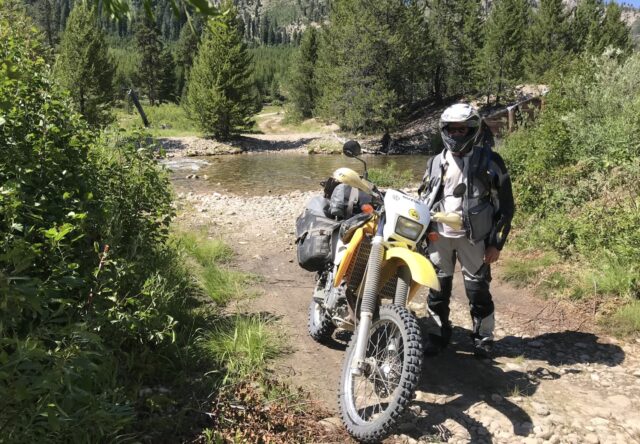
Our purpose here is to inform riders about motorcycles in the 400cc class and above with MSRPs of less than $7,400. Having ridden since long before riding aids were invented, I’ve yet to buy into the need for many of the electronic features, though I do enjoy heated grips, and cruise control is mighty tempting. While riding aids like ABS and traction control can make motorcycling safer, especially for novices, learning to ride without their assistance will make you a better rider. After 5 decades in the saddle, I’m still happy with an uncomplicated, decent handling machine that will take me to the middle of nowhere and back.
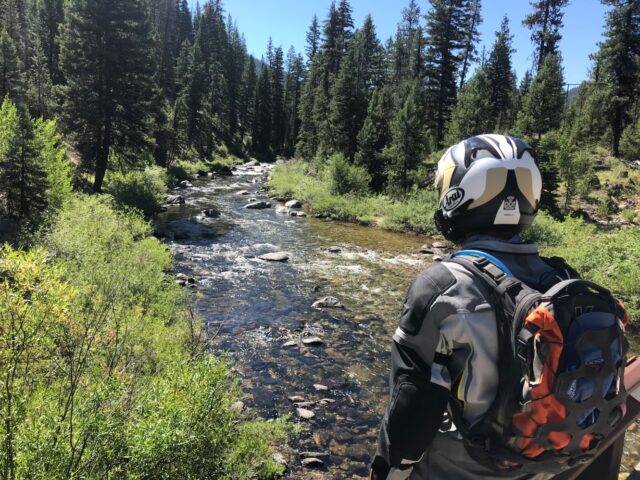
Performance Data
A note about horsepower and torque numbers: not all manufacturers supply them. Where they do, the values are generally greater than those recorded in the dynamometer runs performed by Dirt Rider and Cycle World magazines. If available, these dyno numbers are denoted by DR and CW in the engine performance specifications. Unless otherwise noted, motorcycle weights are those provided by the manufacturers as “curb,” which includes a full tank of gas, oil in the crankcase, and a battery.
The Motorcycles
The motorcycles here are the latest versions of a given model available in the US at the time of publication. In some cases, earlier models may be available at a lower price.
Our ten affordable adventure machines are:
- 2026 Royal Enfield Himalayan 450 ($5,999-$6,399)
- 2026 CFMOTO Ibex 450 ($6,499)
- 2026 KLE500 ABS ($6,599)
- 2026 Triumph Scrambler 400 XC ($6,895)
- 2026 Kawasaki KLR 650 ($6,999-$7,299)
- 2025 Honda XR650L ($6,999)
- 2026 KTM 390 Adventure R & X ($6,999, $5899))
- 2024 Suzuki DR-Z 400S ($7,199; remaining 2023 models available for less)
- 2026 Suzuki DR650 ($7,299; remaining 2023, 2024 ,2025 models available for less)
- 2025 Honda NX500 ($7,399)
In many ways, this review pits old versus new. The Kawasaki KLR650, Suzuki’s DR650, and the Honda XR650L are all over 30 years old, while the Triumph Scrambler XC and Kawasaki KLE500 ABS are brand new for 2026. The Himalayan is a total makeover of the previous model, as is the KTM 390 Adventure R. For the bargain hunter, the advantage of a longer product run is a higher quantity of suitable used vehicles. Full disclosure: I’ve owned an ’87 and a ’97 KLR 650 and recently sold my ’03 DR-Z.
2026 Royal Enfield Himalayan 450 ($5,999-$6,399)
The 2026 Royal Enfield Himalayan 450 was a completely new machine when introduced in 2024, boasting more power, more amenities, and better suspension than the 2023 model previously in this slot. And depending on the color chosen, it’s only $500 more than the earlier version. In a nutshell, Enfield transformed the Himalayan from a simple, capable—if slow—machine into a modern ADV bike that can mix it up with others in this class.
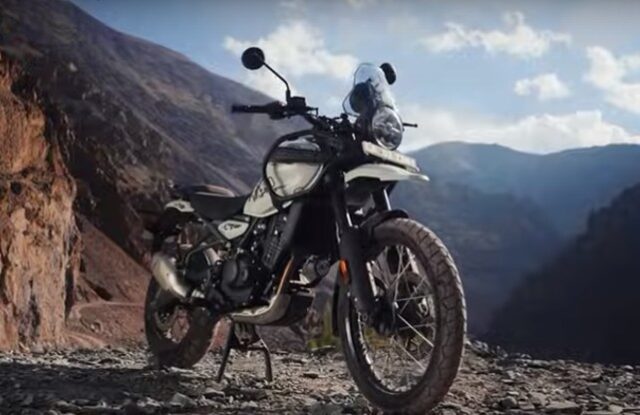
Topping the upgrades is the new 452 cc, 4-valve, fuel-injected single that puts out a claimed 39.5 horsepower—65 percent more than the 2023 two-valve mill could muster. Torque gets a big bump as well, from 21.8 to 29.5 pound-feet. This enormous power increase allows the Himalayan to conquer hills, float through sand, and make time on the tarmac much better than before. As a bonus, engine weight dropped by 10 pounds.
Assisting in faster travel is a 6-speed transmission, up from the previous 5-speed model. This gives the 450 an overdrive cog for the long, paved stretches, while the assist/slipper clutch eases shifting chores.
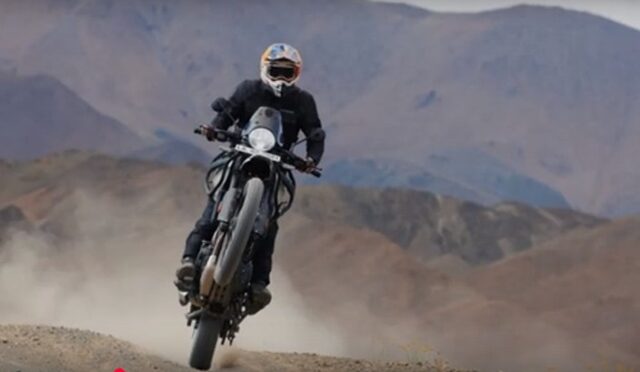
New tech is on display with a customizable, 4-inch TFT unit presenting pertinent data to the rider. Mapping and smartphone connections are also included, as are complete LED lighting and a charging port. The ride-by-wire throttle begets riding modes, of which there are four: ABS On, and ABS Off for both Performance and Eco throttle settings.
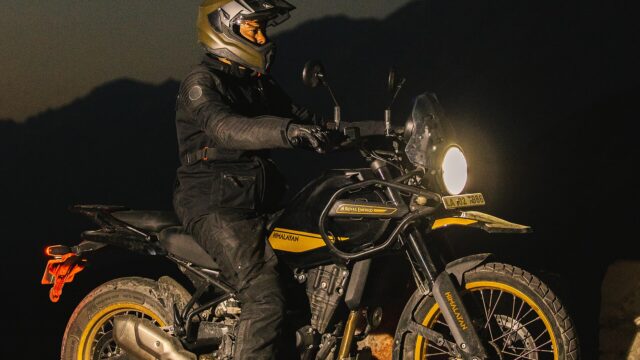
The new Himalayan has the same 21- and 17-inch wheel sizes as its predecessor but sports a larger rear tire. New, modern suspension makes the ride more comfortable. The 43mm inverted fork is 2mm larger than the previous model for a more solid front end, and the rear has an upgraded monoshock. A 4.5-gallon fuel tank enables deep dives into the back of beyond. While the previous Himalayan will get you most anywhere on the map, the 450 is destined to make every ride less work and more fun.
Specifications
Engine type: 452cc liquid-cooled, fuel-injected 4-valve DOHC single-cylinder 4-stroke
Engine performance: 39.47 horsepower @ 8,000 rpm; 29.5 pound-feet @ 5,500 rpm
Fuel capacity: 4.5 gallons
Transmission: 6-speed constant mesh; wet, multi-plate slip and assist clutch
Suspension / Front: Inverted 43 mm fork; 7.9 inches travel
Suspension/ Rear: Monoshock with linkage, preload adjustable; 7.9 inches travel
Brakes / Front: Single 320 mm disc, 2-piston caliper, switchable dual-channel ABS
Brakes / Rear: Single 270 mm disc, single piston caliper
Tire / Front: 90/90 – 21 (tubeless available)
Tire / Rear: 140/80 – 17 (tubeless available)
Seat height: 31.7 – 32.5 inches, adjustable (low seat available)
Ground clearance: 9.0 inches
Weight: 432 pounds (claimed, w/90 percent fuel load)
Origin: India
CFMOTO Ibex 450 $6,499
New to our list this year, CFMOTO’s built-for-adventure Ibex 450 offers good horsepower, tons of tech, and looks sharp. Reviews from its 2025 debut were largely positive, and the bike hasn’t changed for 2026.
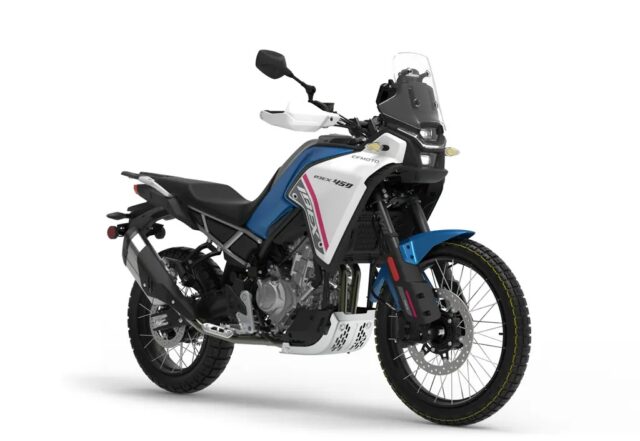
CFMOTO’s 449cc twin-cylinder Ibex checks a lot of boxes for newer riders and those not looking to push the envelope. While not the most powerful in the group, there are plenty of ponies to take on a BDR and the suspension necessary to do so. The twin has also been reported to be smooth from idle to redline. With its 4.6-gallon tank and the 50-mpg fuel economy noted by Cycle News, an adventurer can see a lot of country before filling up. The 450’s two ride modes, Standard and Off-road, can be swapped while moving, making it Ibex ready for any road at any time. Perhaps best of all, it’s affordable.
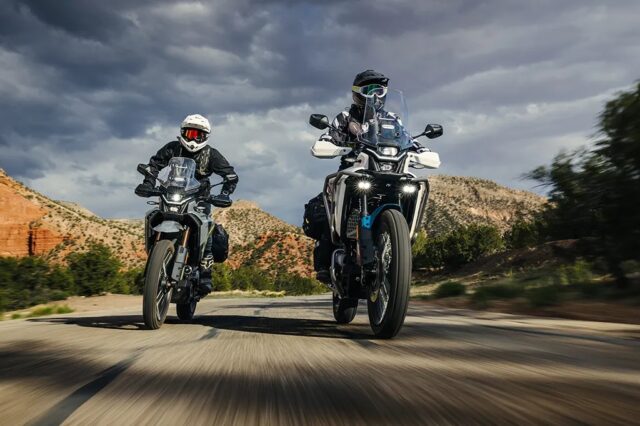
The Ibex 450 has goodies galore for the pilot, starting with full LED lighting and a 5-inch TFT display, and connectivity with Bluetooth and CFMOTO’s Ride Sync. The latter enables controlling your phone from the handlebar. A USB-C port allows device charging while riding, and the windscreen can be adjusted by hand as you ride. The Ibex protection package includes folding mirrors, hand guards, and a skid plate. To accommodate more riders, the seat adjusts from 32.3 inches to 31.5 inches. Those needing more height can opt for a taller rally seat.
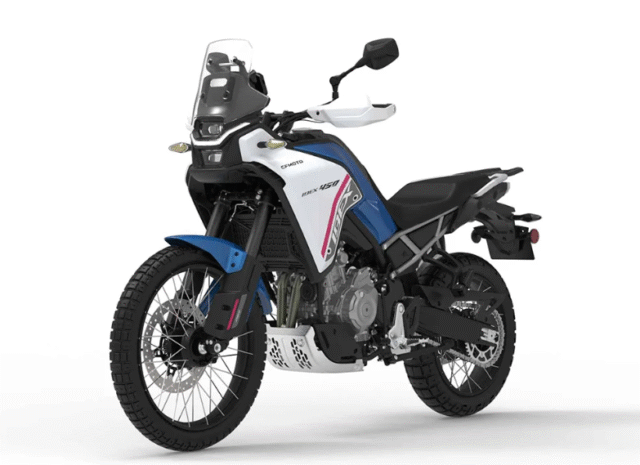
Rolling gear is the classic 18-/21-inch combo which supports tubeless tires, a boon to those prone to flats. Still, it’s good practice to carry a spare 21-inch tube (fits in any tire for short distances), tire irons, and a pump in case of a slit sidewall. The ABS uses twin discs on the front end with a single platter at the rear. Rear ABS can be turned off.
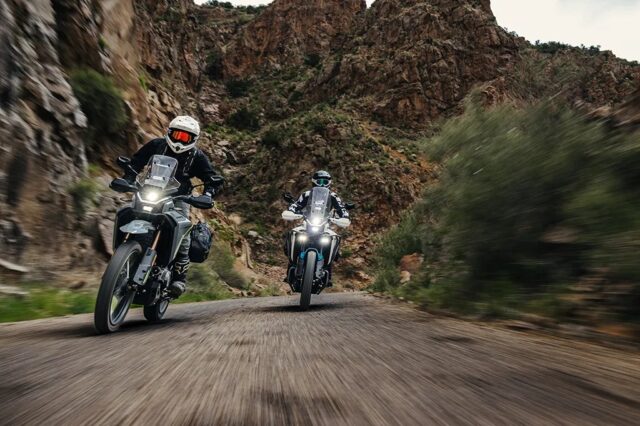
While CFMOTO is fairly new to the U.S., it’s a mature manufacturing organization that produces engines and entire motorcycles for KTM and other companies. With their Ibex 450, they’ve put together a lot of bike for $6,499, and include a 2-year factory warranty.
Specifications
Engine type: 449 cc liquid-cooled, fuel-injected, 8-valve, DOHC inline twin-cylinder 4-stroke
Engine performance: (CW) 37.1 horsepower @ 8,920 rpm; 27.1 pound-feet @ 5,490 rpm
Fuel capacity: 4.6 gallons
Transmission: 6-speed, wet, multi-plate, CF-SC slipper clutch
Suspension /Front: 26 mm KYB inverted fork, adjustable pre-load, compression and rebound adjustable; 7.9 inches of travel
Suspension / Rear: Rear: KYB multi-link center aligned, adjustable pre-load, rebound and damping; 7.9 inches of travel
Brakes / Front: 282 mm twin disc, 4-piston caliper, ABS
Brakes / Rear: 245 mm single disc, single-piston caliper, ABS
Tire / Front: 90/90 R 21
Tire / Rear: 150/70 R18
Seat height: 35.0 inches (adjustable to 31.5), taller seat available
Ground clearance: 10.0 inches
Weight: (CW) 448 pounds
Origin: China
cfmotousa.com
Kawasaki KLE500 ABS ($6,599)
The guys in green are also joining the mid-range ADV machine bandwagon, introducing two new KLE500 ABS models. The base model easily makes our price point, but their Special Edition version of the modern 451cc twin is priced out by a mere $99. No worries, as most of its extra value is niceties, not performance.
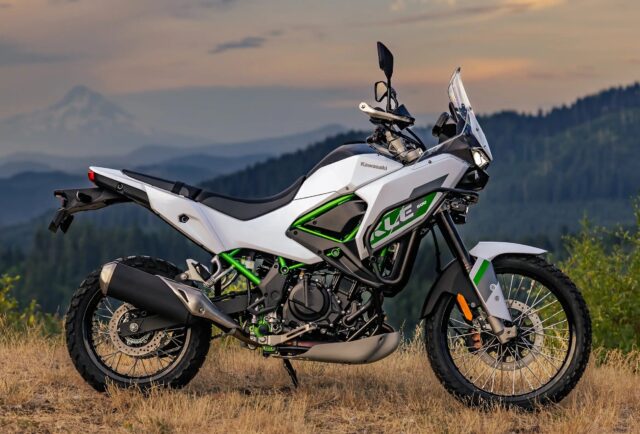
Starting with an engine already in service with their Ninja 500 and Eliminator models, Kawasaki took the rally look and ran with it. They claim the fuel-injected twin puts out 51 horsepower at a rev-happy 10,000 rpm, with 31.7 pound-feet of torque on hand at 7,500 rpm. That should be plenty for fun from the twisties and the rough stuff. They’ve kitted out the new moto with a set of 21-/17-inch front/rear spoked rims, the same sizes used on the KLR 650 since the original ’87 model hit the road.
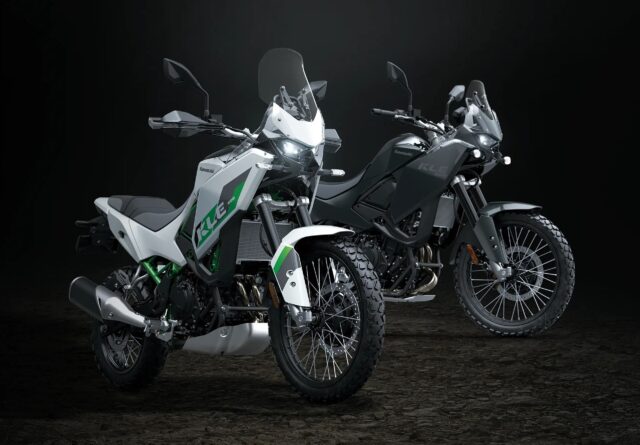
Ground clearance is where the KLE500 suffers a bit. Just 6.8 inches separates it from a big smack in the belly. Kawasaki armored the bike with a skid pan just for this reason. Suspension components appear better than a KLR, with a 44mm inverted fork providing 8.3 inches of travel and a single rear shock that travels 7.9 inches. With traveling in mind, Kawasaki gave the 500s a unified trellis-style frame that includes a strong tail portion for holding a top box and panniers. The low, up-swept exhaust was designed not to interfere with luggage.
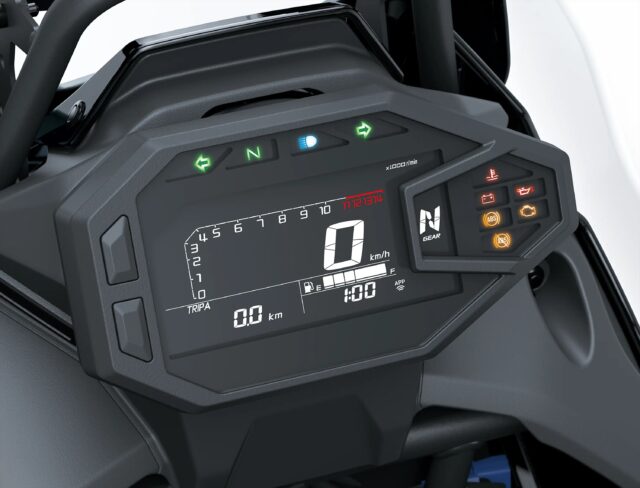
Kawasaki says the bike is inspired by rally machines, which is obvious by the styling. A narrow tank will aid body movement, whether sitting or standing, and a tall windscreen that hints at the Dakar aspirations. The LCD instrument panel is functional, if not flashy, and has phone connectivity via Kawi’s Rideology app. Three modes of ABS—On, All Off, Rear Off—let the rider choose the best braking for the situation. Seat height is a reasonable 33.8 inches, and the tank holds 4.2 gallons, plenty for most riding.
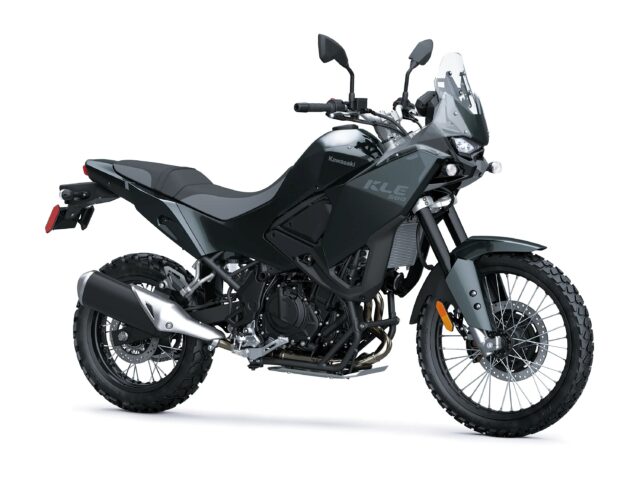
The KLE500 ABS looks to be a bike for everyone, from casual backroad riders to BDR adventurers, though the latter would have to be careful in the rocks.
Specifications
Engine type: 451cc liquid-cooled, fuel-injected 4-valve, DOHC, twin-cylinder four-stroke
Engine performance: (claimed, from similar model) 51 horsepower at 10,000 rpm; 31.7 pound-feet of torque at 7,500 rpm
Fuel capacity: 4.2 gallons
Transmission: 6-speed with slipper/assist clutch
Suspension / Front: 43 mm inverted front fork; 8.3 inches of travel
Suspension / Rear: Single rear shock, preload adjustable; 7.7 inches of travel
Brakes / Front: Single 300 mm disc, radial-mount 2-piston caliper, ABS
Brakes / Rear: Single 230 mm rear disc, 2-piston caliper, ABS
Tire / Front: 90/90-21
Tire / Rear: 140/70-17
Seat height: 34.3 inches
Ground clearance: 7.3 inchesWeight: (claimed) 430 pounds
Origin: Japan
kawasaki.com
Triumph Scrambler 400 XC ($6,695)
The Scrambler 400 XC follows the Speed 400 and Scrambler 400 X as Triumph’s third motorcycle in their 400cc lineup. While the X model will handle dirt roads, its cast-aluminum rims limit the hard knocks it can take on rougher stuff. Triumph looked at the X and made changes that turn the Scrambler into a much more capable machine for exploration. They’re asking $6,695 for the XC, a $700 increase over the X.
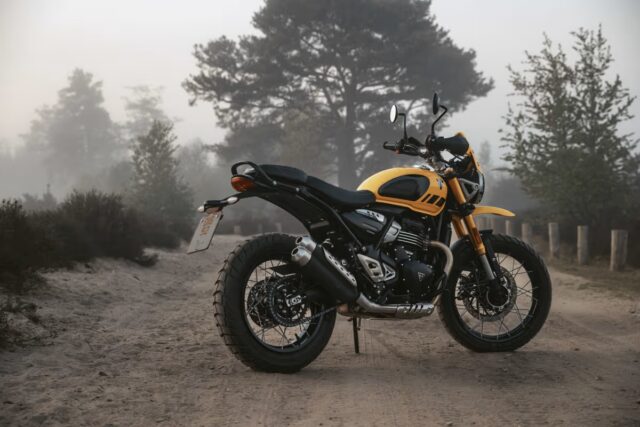
A big step in the ADV direction was swapping out the X’s rims for spoked aluminum Excel hoops that hold tubeless tires for easier flat repairs. Triumph fitted Metzeler’s Karoo Street tires to the XC’s new rims but kept the 19- and 17-inch front/rear sizes. Not the ideal setup for adventuring, but workable and more fun on the pavement.
The Scrambler 400 XC’s powerplant hasn’t changed from the X model, a 4-valve DOHC single displacing 398cc. Bosch fuel injection fills the combustion chamber, which operates at a 12:1 compression ratio. The result is a claimed 39.5 horsepower at 8,000 rpm and 27.7 pound-feet of torque at 6,500 rpm, making for a peppy single. Power runs through a slip/assist clutch that delivers an easy lever pull and protection from clutzy downshifts. The Scrambler’s stainless-steel, dual-layer header feeds exhaust to its handsome stainless silencer.
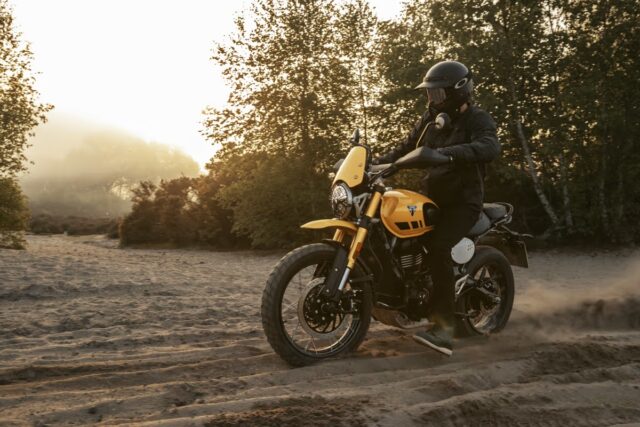
The 400 XC also rides on the same suspension as the X, a gas monoshock with reservoir for the rear, and 43mm inverted Big Piston fork. However, both ends have a conservative 5.9 inches of travel, which may limit any hijinks in the rough going. The stablemates also share single-disc brake setups. ABS, including an off-road mode, is standard, as is switchable traction control.
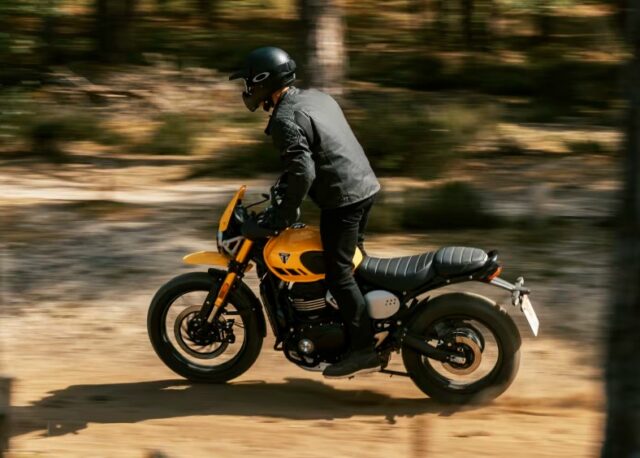
Triumph gave the XC a small flyscreen for style and a bit of wind protection, with paint to match the high front fender. Its small skid pan will deflect rocks and mud from the crankcase and lower header pipe. Like the X, it has switchable ABS and traction control but features a color TFT display instead of an LCD unit.
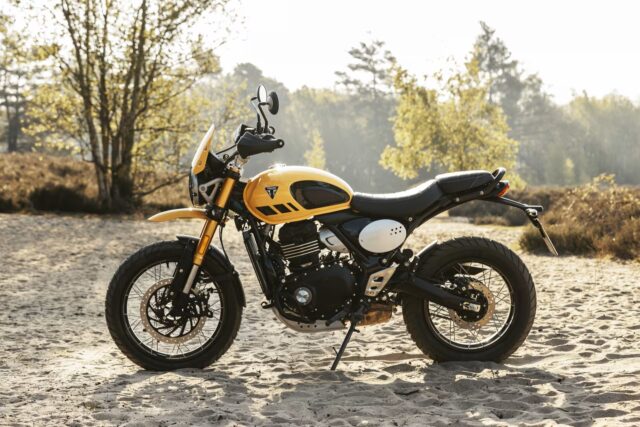
If your adventures are on the milder side, the XC should be a fun ride with its grippy footpegs, wide handlebar, and enough fuel onboard for exploring. Smaller riders might prefer the lower and lighter Scrambler X. The $700 price differential will buy a lot of gas.
Specifications
Engine type: 398cc liquid-cooled, fuel-injected 4-valve, DOHC, single-cylinder four-stroke
Engine performance (claimed): 39.5 horsepower @ 8,000 rpm; 27.7 pound-feet @ 6,500 rpm
Fuel capacity: 3.4 gallons
Transmission: 6-speed, slip/assist clutch
Suspension / Front: 43 mm inverted front fork; 5.9-inch travel
Suspension / Rear: Single rear shock; 5.9-inch travel
Brakes / Front: Single 320 mm disc, radial-mount 4-piston calipers, ABS
Brakes / Rear: Single 230 mm rear disc, single piston floating caliper, ABS
Tire / Front: 100/90-19 spoked wheel, tubeless tire
Tire / Rear: 140/80-17 spoked wheel, tubeless tire
Seat height: 32.6 inches
Ground clearance: N/A
Weight: (claimed) 410 pounds
Origin: India
2026 Kawasaki KLR 650/650S ($6,999-$7,299 w/ABS)
The KLR 650 has a devoted following, and with good reason—they’re solid, uncomplicated machines for travel and backcountry riding. Being one of the earliest affordable machines to manage highway, byway, and two-track travel while carrying a pile of gear didn’t hurt their popularity. I had two over a span of 19 years while waiting for the right new motorcycle to come along (it was a BMW F 800 GS).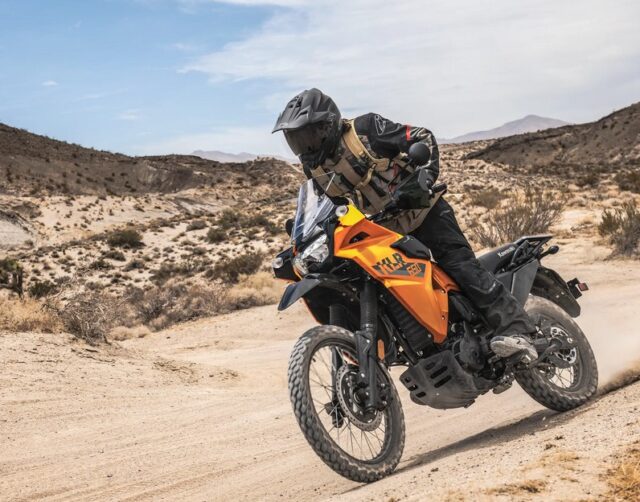
Kawasaki created the KLR from the KLX 600 off-roader in 1987, beginning over three decades of production. Colors and graphics changed regularly, but it wasn’t until 1996 that significant, though largely unseen, updates occurred. In 2008, the bike received a major update with better brakes, improved suspension, and other mods. Having road-tested that model, I can vouch for the improvements.
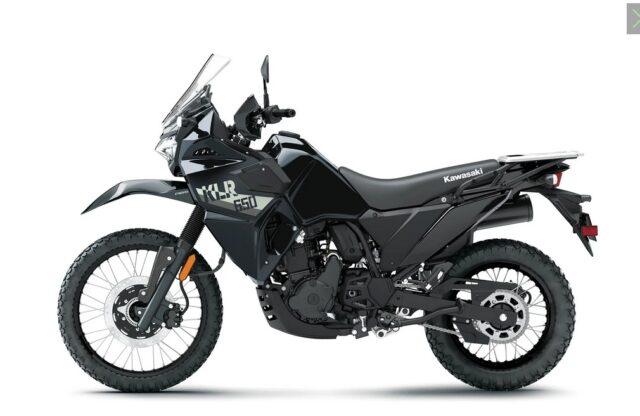
The KLR returned from a production hiatus from 2019-2021 with fuel injection, optional ABS, and other enhancements. Of the three versions available for 2026, the standard and the lowered “S” model meet our cost criteria, with or without ABS. With each round of improvements, the never-svelte KLR gained weight. Today’s non-ABS standard has plumped up to 456 pounds from 432 in 1987-2017. That’s a lot to control from a 34-inch-high seat, especially with the bike loaded for traveling.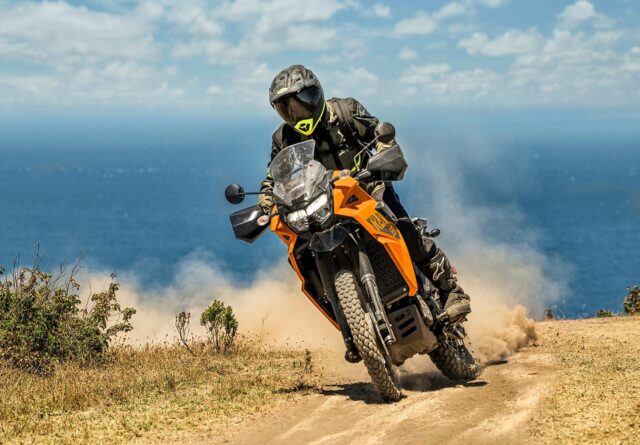
A popular attribute of the KLR is its long range, thanks to a 6.1-gallon gas tank and excellent fuel economy. The seat on the 2022 and later editions is also getting high marks for comfort, should you want to drain the tank in one sitting. Another enduring feature is the large rear rack, ready to hold a pile of luggage. Be aware that on older models, the muffler will melt the right-hand panel if there’s too much weight on it. My penny-tech solution was to jam a squashed soda can under the panel.
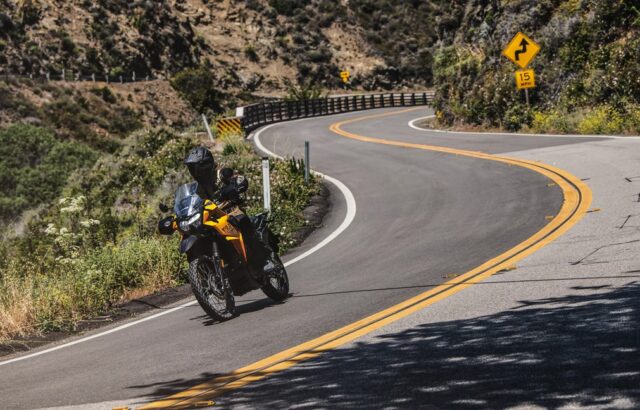
None of the veteran 650s here are known for blazing horsepower, but the KLR has by far the most weight to move. While it cruises at freeway speeds without complaint, it’s not the quickest when passing traffic on a two-lane road. Given all the modern competition and whizzy tech available, price and raw ability still move KLRs off the showroom floor.
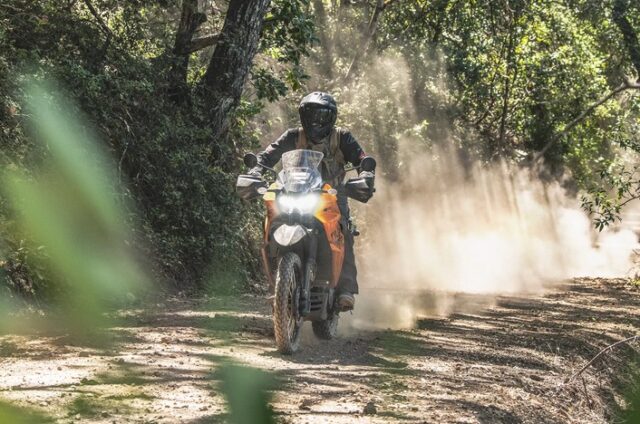
Though not fancy, the Kawasaki KLR650 has always been an affordable, durable machine for its size and remains so to this day.
Specifications (S model values in brackets)
Engine type: 652cc liquid-cooled, fuel injected 4-valve, DOHC single-cylinder 4-stroke
Engine performance: (DR) 34.6 horsepower @ 5,900 rpm; 33.5 pound-feet @ 4,700 rpm
Fuel capacity: 6.1 gallons
Transmission: 5-speed, wet multi-plate clutch
Suspension / Front: 41 mm conventional fork; 7.9 [6.7] inches of travel
Suspension / Rear: Uni-Trak single shock, adjustable preload, and rebound damping; 8.0 [7.0] inches of travel
Brakes / Front: Single 300 mm disc, 2-piston calipers (optional ABS)
Brakes / Rear: Single 240 mm disc, single-piston caliper (optional ABS)
Tire / Front: 90/90-21
Tire / Rear: 130/80-17
Seat height: 34.3 [32.1] inches
Ground clearance: 8.3 [7.8] inches
Weight: 456.2 pounds / 460.6 w/ABS
Origin: Japan
2025 Honda XR650L ($6,999)
Honda calls their XR650L “one of the most honest, straightforward motorcycles on the planet.” It’s hard to argue that point, given it’s a motorcycle that has been popular since it first hit the showroom floor over 30 years ago. Today’s bike is nearly the same machine with a few minor tweaks made over the years, and is arguably the most dirt-worthy of this group. The XR650L is an offspring of the NX650, a streety -sport that was short-lived in the States. Honda mated the NX’s 644cc RFVC (radial four-valve combustion) engine to their off-road-only XR600R’s frame and came up with a winner.
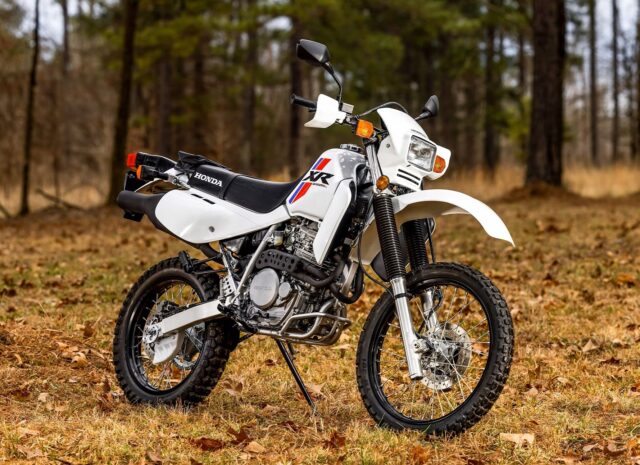
The XR’s carburetor and 5-speed gearbox reveal its age, but that doesn’t stop it from logging many comfortable miles off the pavement. At 8.3:1, this bike has the lowest compression ratio on our list and should burn fuel that others would choke on. The compact motor’s dry-sump design, where oil is stored in the frame tubing, saves weight and increases ground clearance. The XR also has a stellar reputation for reliability.
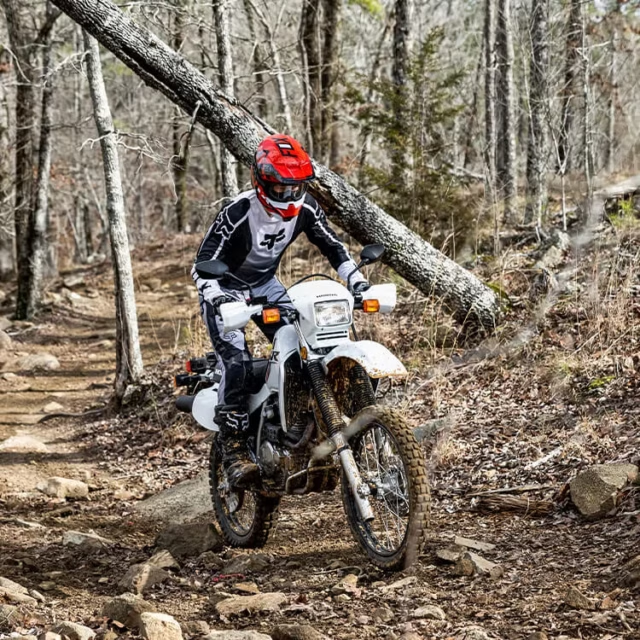
Though far from being a powerhouse, Honda’s 650 has plenty of ponies for brisk freeway travel. And with torque numbers approaching those for horsepower, there’s no worry of stalling on a hill climb. The big item missing is fuel capacity. A friend of mine bought a used ’94 XR650L equipped with a 5-gallon Acerbis tank. By adding racks and panniers, he was set for the 10-day southern Utah camping tours we did in the late 90s.
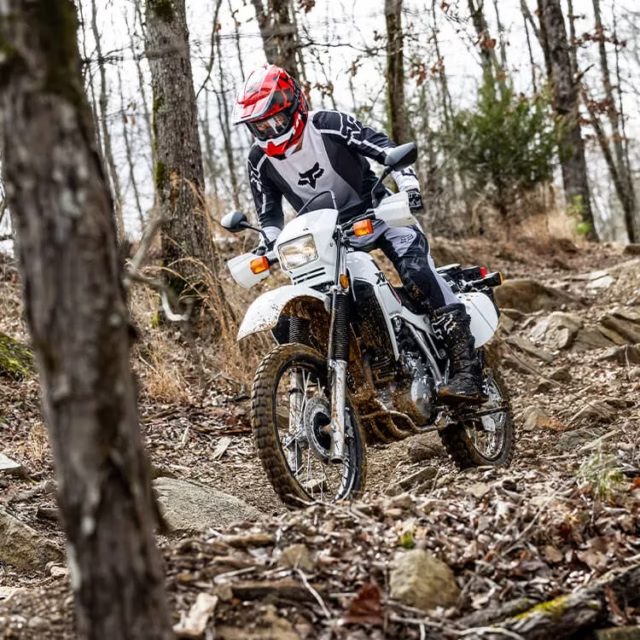
The XR’s Everest-like 37-inch seat height did give him enough trouble that he had the seat pared down. Regarding the suspension, he said, “The travel was huge, and the ride was plush.” Thirteen inches of ground clearance do give those 11 inches of front and rear travel plenty of room to move. There’s no skid pan, but a tubular guard crosses the lower frame members to offer some protection to the cases.
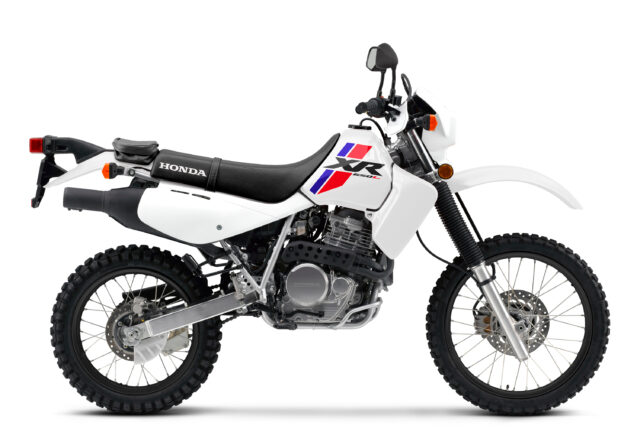
More expensive machines can outrun and outgun the XR650L, but its gritty demeanor and renown for reliability help it finish way ahead in the smiles per dollar race.
Specifications
Engine type: 644cc air-cooled, carbureted 4-valve, SOHC/RFVC single-cylinder 4-stroke
Engine performance: (DR) 34.1 horsepower @ 6,100 rpm; 31.4 pound-feet @ 5,300 rpm
Fuel capacity: 2.8 gallons
Transmission: 5-speed
Suspension / Front: 43 mm air-adjustable cartridge fork with adjustable compression damping; 11.6 inches of travel
Suspension / Rear: Pro-Link single-shock with adjustable spring-preload and compression/rebound damping; 11.0 inches of travel
Brakes / Front: Single 256 mm disc with 2-piston caliper
Brakes / Rear: Single 220 mm disc with single-piston caliper
Tire / Front: 3.00-21
Tire / Rear: 4.60-18
Seat height: 37 inches
Ground clearance: 13 inches
Weight: 346 pounds
Origin: Japan
KTM Adventure R & X
Say goodbye to the 2024 390 Adventure and make way for two new models, the Adventure R and X. Not a company to let a good bike get stale, KTM made some serious updates to these 390s for 2025. Chief among these is the new 399cc LC4c engine sourced from their 2025 Enduro R, plus improvements to its 6-speed gearbox. A boost of 6.8 horsepower and 5.6 pound-feet of additional torque over the 2024 model should leave earlier 390s in the dust.
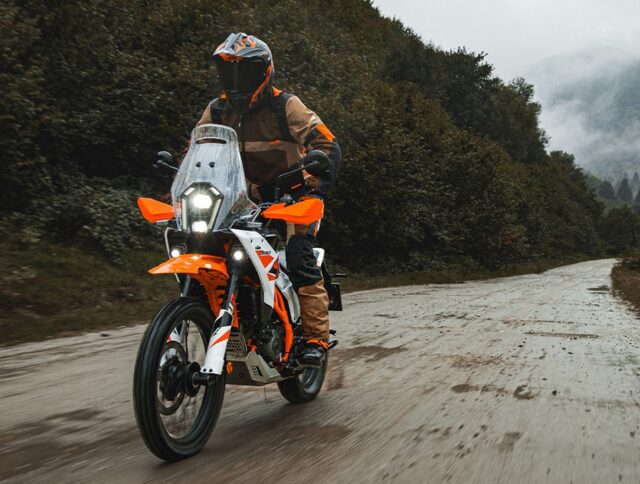
The 2026 R version is the most capable multi-surface machine of the two, so we’ll focus on it for adventuring. The largest difference between the R and X is the R’s 18- and 21-inch spoked wheels versus the X’s 17-/19-inch cast wheelset. The R model’s better suspension travel at both ends seals the deal for it being the better choice for hard riding. KTM didn’t skip on the R’s tires either—the Adventure R rides on top-tier Mitas Enduro Trail E07+ rubber. 10.7 inches of ground clearance allow for aggressive riding.
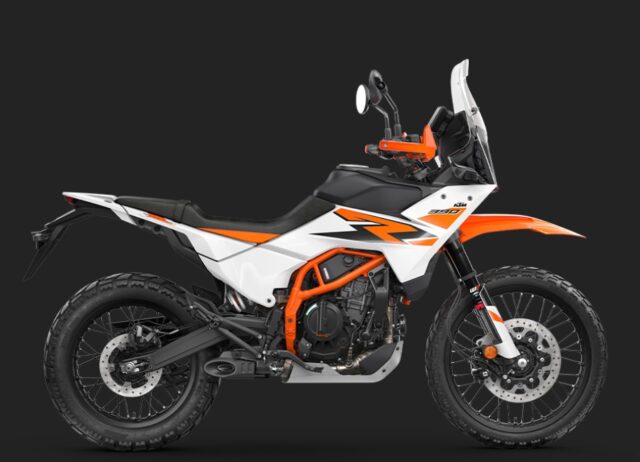
The new 390s boast a stronger steel frame in the classic KTM trellis style, plus an updated steel subframe bolted onto it. KTM also took the opportunity to refine handling in the dirt by tweaking the steering head angle and triple clamps. The slip/assist clutch from last year is still in place to provide smooth shifting as well as reducing clutch pull effort. While this may sound trivial to newer riders, working the clutch to maintain traction in difficult terrain can take a toll on the left hand. The up-down quick shifter option to provide clutchless gear changes in both directions is still available as well.
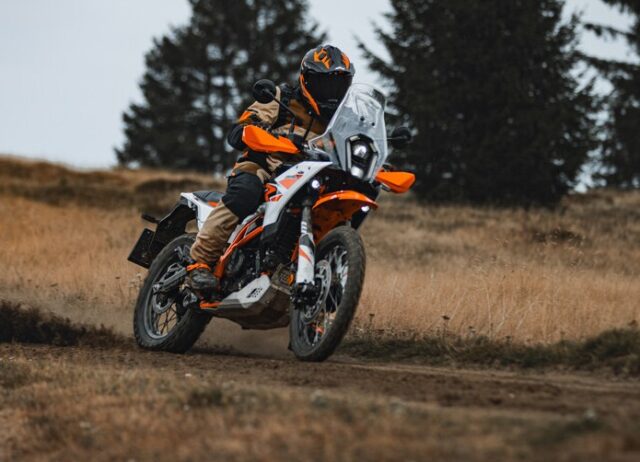
The Adventure R’s data display is a 5-inch TFT, mounted high for the peg-standing adventure crowd. Its three ride modes are labeled Street, Offroad, and Rain, but can be customized to the rider’s preference regarding traction control, ABS, and throttle response. KTM doesn’t allow turning off front-end ABS, but its effect is limited when in Offroad mode. The gas tank holds a generous 3.7 gallons.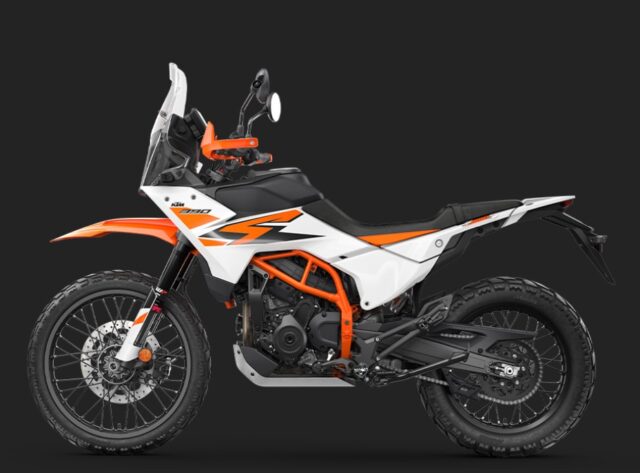
The 390 Adventure has morphed quickly from its 2020 origins as a dual-sport that could manage a BDR to a true ADV machine built for the backroads. And at $6,999, the R costs $600 less than the 2024 model. It’s the most expensive of KTM’s dirt-worthy duo but well worth the extra cash for its adventure capability. Add luggage, grab a map, and the back of beyond is yours to explore.
The X model has a lower seat and lists for just $5,899, making it a good option for newer riders who want to take a stab at dirt riding.
Specifications
Engine type: 399cc liquid-cooled, fuel-injected 4-valve, DOHC, single-cylinder four-stroke
Engine performance (claimed): 45 horsepower at 8,500 rpm; 28.8 pound-feet @7,000 rpm
Fuel capacity: 3.7 gallons
Transmission: 6-speed
Suspension / Front: 43mm WP Apex inverted front fork; 9.1-inch travel, adjustable compression and rebound
Suspension / Rear: Single rear WP Apex shock; 9.1-inch travel, adjustable preload
Brakes / Front: Single 320mm disc, radial-mount 2-piston calipers, ABS
Brakes / Rear: Single 240mm rear disc, single piston floating caliper, ABS
Tire / Front: 100/90-19 spoked wheel, tubeless tire
Tire / Rear: 140/80-17 spoked wheel, tubeless tire
Seat height: 34.2 inches
Ground clearance: 10.7 inches
Weight: (claimed wet) 388 pounds
Origin: India
2024 Suzuki DR-Z 400S ($7,199)
It’s not every day that a stranger tells you that you’re riding “the best damn BDR bike for the money.” It happened to me along the Magruder Corridor on the Idaho BDR and came from a KTM rider. I have to say I agree with him. My own DR-Z 400S dates from 2003, and Suzuki has changed it little since then. A carbureted engine and 5-speed transmission are the most notable signs of its age, but have no effect on getting from A to B comfortably. While its 2.6-gallon fuel capacity is fine for dual-sport runs or shopping trips, adventure travel requires something larger; I fitted an IMS 4.2-gallon tank. The headlight uses the common 55W/60W H4 bulb for mediocre lighting.
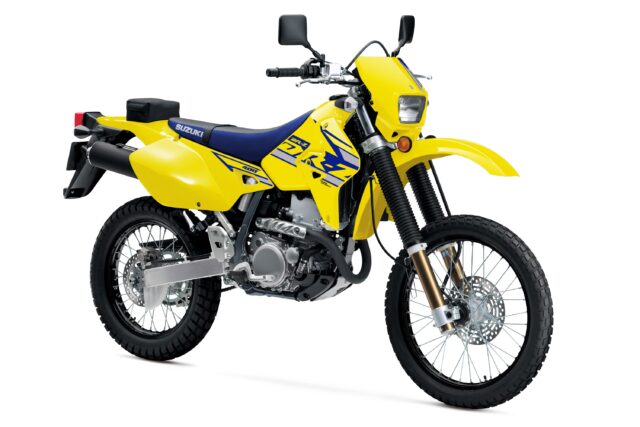
While not state-of-the-art, the Suzuki’s long-travel front and rear suspension keep the bike on track over the bumps and ruts. Tailor it to your mission with spring preload at both ends, front fork compression and rebound damping, and rear shock compression damping. I credit the suspension for a crash-free IDBDR run, in spite of several steep, rocky sections where I hung on and bashed through. The DR-Z’s steel frame holds oil for the dry sump motor, saving some weight overall and making it the lightest motorcycle here.
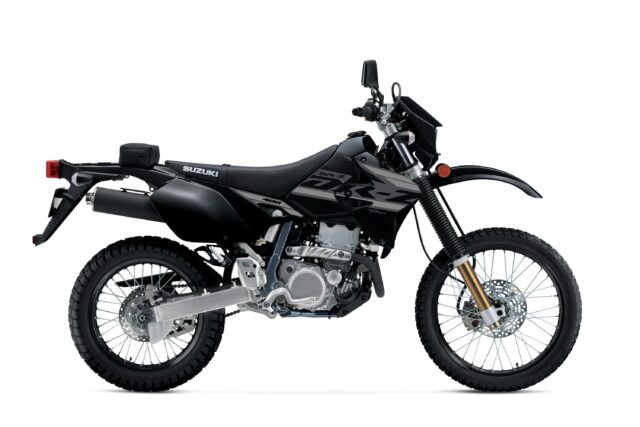
With engines this small, the carburetors have very small jets that become clogged by evaporating fuel when the motorcycle is left to sit, forcing a cleaning or rebuild. I’ve done that a few times. On the plus side, the Suzuki’s BSR36 Mikuni constant-velocity carb does not require re-jetting for altitude, a real plus in the Idaho mountains.
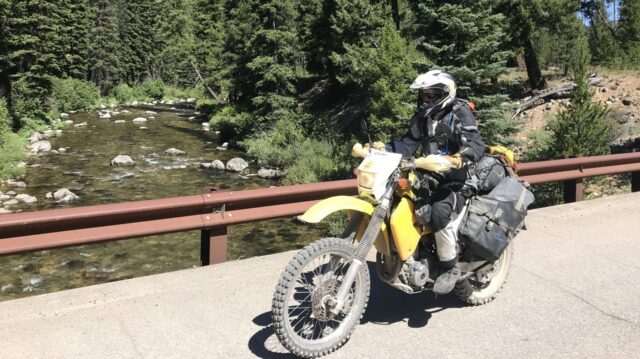
Nearly 32 horsepower makes the DR-Z capable of carrying rider and gear for an extended journey. It cruises comfortably at freeway speeds, though not the 80 mph legally possible in some states. Vibration is evident but not obnoxious. Motorcycles like the 400S stay around for 20+ years because they do their job well enough to satisfy a lot of riders. There are always things to add, like wider footpegs and a decent skid plate, but it doesn’t take much to make the DR-Z adventure-ready. I did have the seat cut down from the nearly 37-inch stock height.
This is a bike a new rider could learn on and then enjoy for many years—precisely why I kept mine for so long.
Specifications
Engine type: 398cc liquid-cooled, carbureted, 4-valve DOHC, single-cylinder 4-stroke
Engine performance: (DR) 31.8 horsepower @ 8,400 rpm; 24.3 pound-feet @ 6,600 rpm
Fuel capacity: 2.6 gallons
Transmission: 5-speed, wet multiplate clutch
Suspension / Front: 49 mm cartridge-style conventional fork, adjustable for compression/rebound damping and spring preload; 11.3 inches of travel
Suspension / Rear: Progressively linked single shock adjustable for compression and preload; 11.6 inches of travel
Brakes / Front: 250 mm front disk, 2-piston caliper
Brakes / Rear: 220 mm rear disk, single-piston caliper
Tire / Front: 80/100-21
Tire / Rear: 120/90-18
Seat height: 36.8 inches
Ground clearance: 11.8 inches
Weight: 317 pounds
Origin: Japan
2026 Suzuki DR650 ($7,299)
In 1990, Suzuki started down the same path as Kawasaki in creating a 650 dual-sport from their existing DR600. Unlike Honda, who emphasized the dirt aspects of their 650 immediately, Suzuki and Kawasaki both started as long-range, dirt-capable motorcycles with large fuel tanks, 5.5 gallons for the DR and 6.1 for the KLR. When Honda’s XR showed up, Suzuki veered toward the dual-sport market in future developments, leading to the DR’s fuel capacity shrinking to just 3.4 gallons. That needn’t be a show-stopper for adventure touring—a larger tank is only a website away.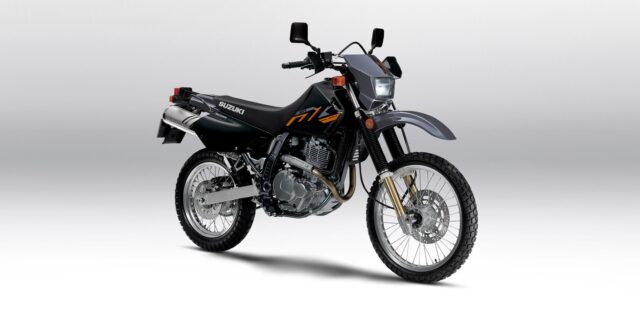
Suzuki shaved 54 pounds off the DR over the years, partly from fuel tank shrinkage but also from intentional weight-saving modifications for the 1996 model. Unusual for a motorcycle update, the bike lost a few horsepower in the process of making the engine physically smaller. On the upside, the power moved into the lower rpm, enhancing control off the pavement. There is also less vibration from the new motor, despite Suzuki removing one of the two balancer shafts. Suddenly the DR weighed only 20 pounds more than Honda’s XR650L.
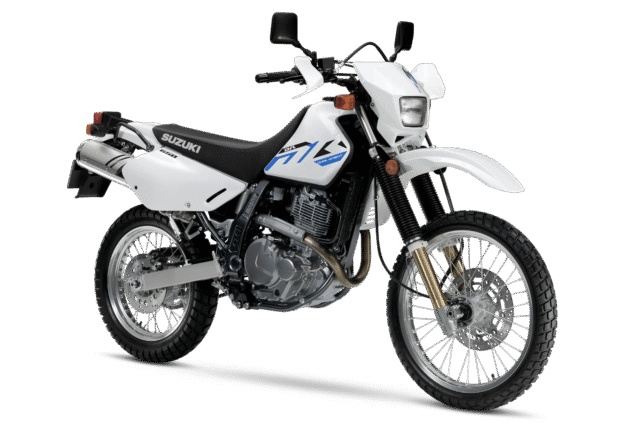
Credit some of the weight loss to the Suzuki Advanced Cooling System, which combines exterior air with interior oil cooling to control engine temperature. High-pressure oil saps heat from hot spots that air can’t touch, like the valves and crankshaft. By sidestepping liquid cooling, the DR is not only lighter, but there are no radiators to damage in a crash. Adventurers take note: Suzuki’s weight-loss initiative also eliminated the luggage rack and skid pan.
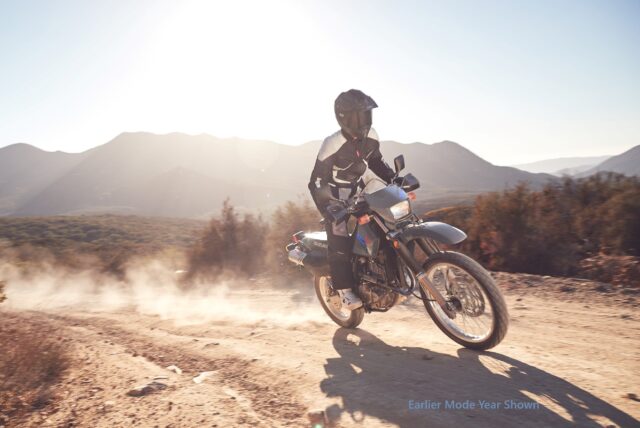
The DR650 is a tall bike in stock form, with a seat height near 35 inches that will challenge some riders. Fear not, as Suzuki accommodates leg-limited motorcyclists with a complete lowering kit right down to a shortened kickstand. The kit brings the seat down to a reasonable 33.2 inches, which should be enough to get some toes on the ground. That brings up the DR’s suspension, which lacks the range of adjustment of the other 650s here.
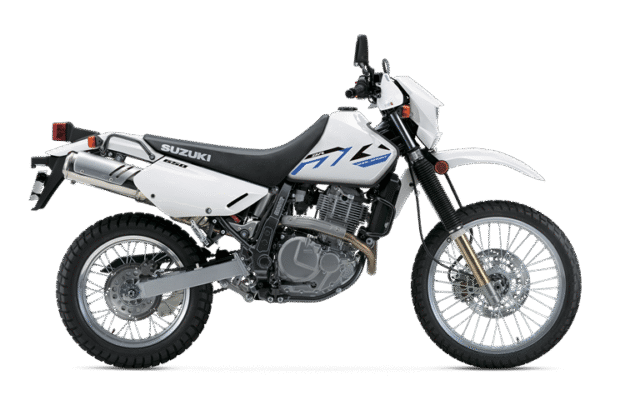
Like the other dual-sports in this list, the DR is an adventure bike in waiting. It requires only two things for off-road exploring, that skid pan and luggage rack. An extra gallon or two of gas in a RotoPax or Giant Loop Armadillo is the least expensive solution to its marginal fuel capacity. The DR650 can take the rough and tumble of the wild, and the carbureted engine is said to be bulletproof, making it a strong contender in the senior 650 crowd.
Specifications
Engine type: 644cc air/oil-cooled, carbureted 4-valve, SOHC, single-cylinder 4-stroke
Engine performance: (DR) 35.1 horsepower @ 6,200 rpm; 32.2 pound-feet @ 4,500 rpm
Fuel capacity: 3.4 gallons
Transmission: 5-speed
Suspension / Front: Height-adjustable conventional telescopic fork; 10.5 inches of travel
Suspension/ Rear: Linked single shock, adjustable for spring preload and compression damping; 10.2 inches of travel
Brakes / Front: 290 mm floating disc, 4-piston floating caliper
Brakes / Rear: 240 mm disc brake, 2-piston single caliper
Tire / Front: 90/90-21
Tire / Rear: 120/90-17
Seat height: 34.8 inches
Ground clearance: 10.4 inches
Weight: 366 pounds
Origin: Japan
2025 Honda NX500 ($7,399)
With the stroke of a pen and a $100 price increase, Honda’s CBX500X became the NX500 for 2025. For that reason, this write-up is much the same as the previous one for the CBX, although somewhere in the transition the bike lost 7 pounds. Perhaps the more adventure-looking bodywork borrowed from the European version of the bike is lighter.

The Honda NX500 will appeal to riders wanting to explore the occasional back road while enjoying all the advantages of a street bike. Were it still the CBX, 2025 would be its 13th year in Honda’s lineup. Over that time, the bike has evolved from a mostly pavement machine to one better equipped for exploring dirt and gravel roads. Early models were essentially street bikes with a touch of adventure styling. As the adventure craze blossomed, Honda filled a gap in their lineup by swapping the CBX’s 17-inch front rim for a 19-incher to improve off-road handling. Longer travel suspension and mild ADV tires were also fitted. Today’s NX500 is a perfectly capable multi-surface machine, though it does have limits.
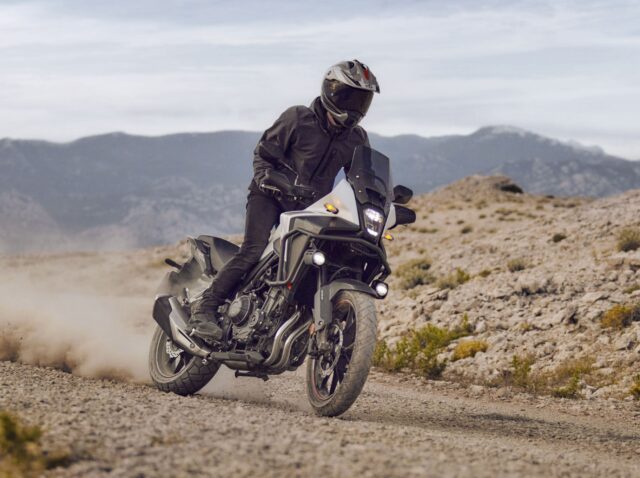
New riders and those wanting to try adventure riding will find plenty to like in this Honda twin, starting with a 32.8-inch seat height. The confidence of having both feet touch the ground can’t be overstated. Nor can the ability to put a foot down when traction takes a holiday. The NX’s ABS is another plus for beginning riders as they work on braking skills, especially on dirt and gravel. However, deactivating the rear ABS to enable slides and skid turns is not an option on this bike. No great loss, as it isn’t a machine for aggressive riding, and you can always pitch it sideways with the throttle for a little fun. The Honda’s assist-slipper clutch will please all levels of riders due to its lighter pull requirement and ability to smooth out botched downshifts.
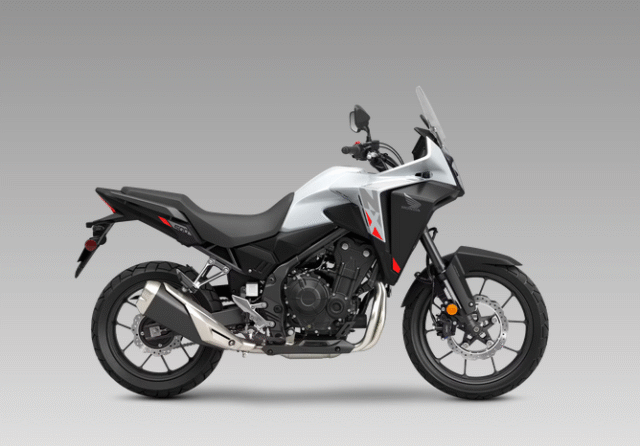
Dirt roads are the Sirens of overland travel. Disappearing into the forest, around a hill, or up a canyon, they lure us to discover their secrets. On an NX500, a rider with some basic skills will feel confident in following them, especially after fitting a more aggressive set of tires. Keep in mind, however, that there is no protection for the bike’s swoopy chromed headers or oil filter, and only 7.1 inches separates the CB’s soft underbelly from the ground. As a pavement bike, the 500 makes a good commuter and traveler. You can do a lot of exploring with 4.7 gallons of gas onboard.
Specifications
Engine type: 471cc liquid-cooled, fuel-injected, 4 valves per cylinder DOHC parallel-twin 4-stroke
Engine performance: (CW, for CB500X) 42.6 horsepower @ 8,430 rpm; 29.6 pound-feet @ 6,520 rpm
Fuel capacity: 4.7 gallons
Transmission: 6-speed
Suspension / Front: 41 mm inverted fork; 5.9 inches of travel
Suspension/ Rear: Single shock with adjustable spring preload; 5.3 inches of travel
Brakes / Front: Dual 296 mm discs with 4-piston calipers; ABS
Brakes / Rear: Single 240 mm disc; ABS
Tire / Front: 110/80-19
Tire / Rear: 160/60-17
Seat height: 32.8 inches
Ground clearance: 7.1 inches
Weight: (claimed) 432 pounds Origin: Japan
Origin: Japan
Decisions, Decisions
All of the motorcycles above have their strengths and weaknesses, yet all are suitable for adventure travel and have been proven so in their years—or decades—on the market. They are not the most powerful beasts of burden for a jaunt up a forest road, but they get the job done. Some are excellent choices for new riders or street riders wanting to learn adventure riding. Others are better suited to riders experienced in traveling the uncertain surfaces that await the adventurer. What puts them all here is reasonable pricing. And what puts riders in their seats is the urge to explore.
Sources
Photographs courtesy of Royal Enfield, Honda, Suzuki, Kawasaki, KTM, Yamaha, CFMOTO, Triumph, and Steve Yates
Read more: ADV Moto Tires
Our No Compromise Clause: We do not accept advertorial content or allow advertising to influence our coverage, and our contributors are guaranteed editorial independence. Overland International may earn a small commission from affiliate links included in this article. We appreciate your support.
Sources
Photographs courtesy of CSC, Royal Enfield, Honda, Suzuki, Kawasaki, KTM, Yamaha, and Steve Yates
KTM photographers: KISKA GmbH, @francesmonterophoto
Read more: Northern California BDR
Our No Compromise Clause: We do not accept advertorial content or allow advertising to influence our coverage, and our contributors are guaranteed editorial independence. Overland International may earn a small commission from affiliate links included in this article. We appreciate your support.


